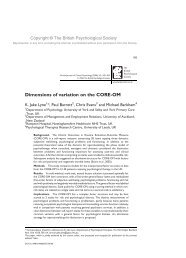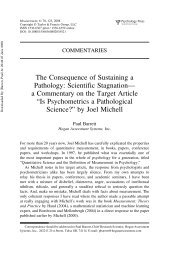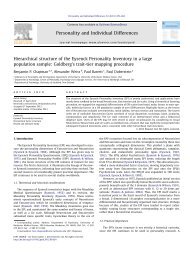Psychophysiological Methods - Paul Barrett
Psychophysiological Methods - Paul Barrett
Psychophysiological Methods - Paul Barrett
- No tags were found...
Create successful ePaper yourself
Turn your PDF publications into a flip-book with our unique Google optimized e-Paper software.
Breakwell-3389-Ch-08.qxd 2/7/2006 8:49 PM Page 158detect this. For a novice researcher, it poses a serious problem. Once again, onlyknowledge of the measurement process and the characteristics of the hardwarecan guard against this incorrect interpretative process.8.3.3 Designing the experiment andchoosing parameters to measureIf you set up an experiment protocol, and have acquired some psychophysiologicaldata, your next problem is deciding what parameters to extract from thesedata. This stage of the measurement process must be decided on the basis of apriori measurement and psychological hypotheses. Data dredging (extractingevery conceivable parameter and attempting to relate them to the psychologicalparameters) in the hope of finding something is virtually impossible to implementin this area. So many parameters can be computed that attempting to siftthrough your data in this manner is a recipe for disaster. You will run out oftime, computing facilities and energy! Modern laboratories routinely keep allphysiological data on some form of archive medium (e.g. magnetic, CD-ROM orDVD). However, only certain hypothesis-specific parameters are extracted fromthis archive for use in the examination of psychological relationships. Shouldother hypotheses evolve over time, the archive data can then be reanalysed(where relevant) in order to permit the extraction of the new parameters.One major problem you may face is that the system you are using to acquirepsychophysiological data may permit only certain forms of analysis or, morerarely, provide no parameters at all. That is, you may have access to a computerbasedskin conductance recording system, which will acquire and store the continuousconductance levels. However, if you do not have a program that analyses thisoutput in terms of response latency and amplitude, then the data are practicallyuseless. Your only options are to write all the incoming data to a chart recorder andcarry out all such measures by hand, or (more usually) obtain or write a computerprogram yourself that implements the procedures necessary to extract these parameters.This highlights another global feature of psychophysiological data acquisition:the collection of data can take a few minutes, but the volume of data generatedcan tax the computer system whilst the analysis of one participant’s data by handcan take days! This is particularly true for methods that measure brain activitysuch as electroencephalography, magnetoencephalography and fMRI where severalgigabytes of data may be simultaneously recorded from a large number of locationsin just a few hours. Even the latest analysis packages running on high-specificationcomputers can take hours to complete each stage of the necessary analysis.Of course, returning to the heart rate example above, it may be that only fivesuch measures are made throughout an experiment, where (say) the only focus ofinterest is the effect of difficulty of task problem on heart rate. The drawback tosuch simple experiments is that the explanatory power of any results is limited bythe paucity of variables analysed! As Fried and Grimaldi (1993) also point out in158 RESEARCH METHODS IN PSYCHOLOGY












